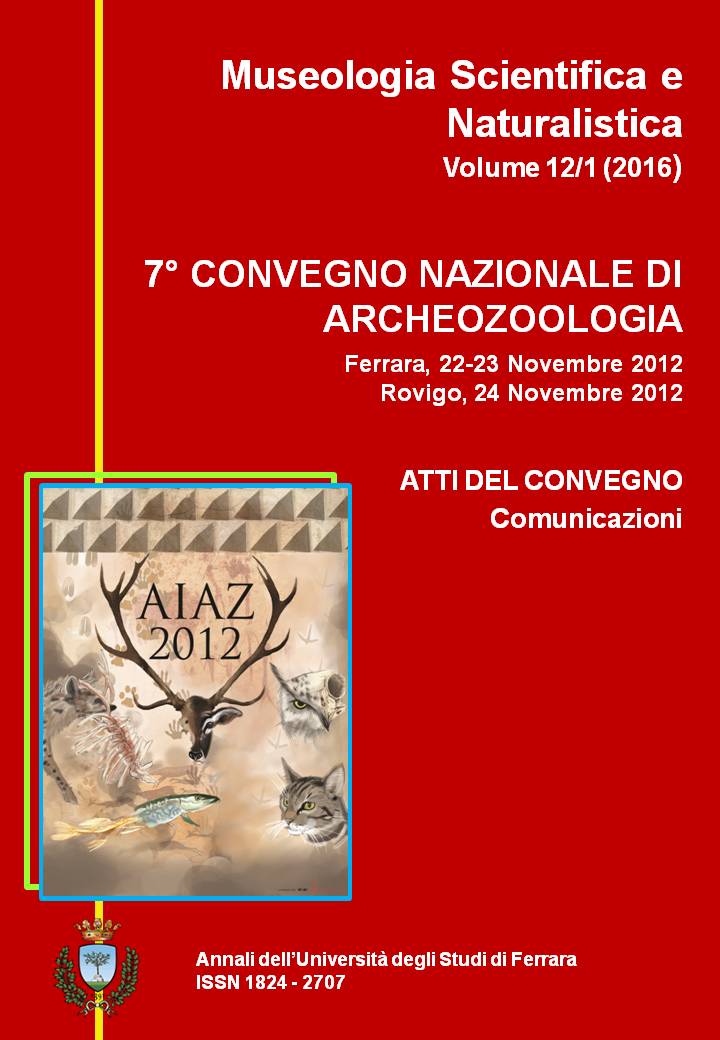Allevamento e caccia al castello di Santa Severa (Roma) durante il basso medioevo: mense signorili e popolari dal XIII al XIV secolo.
DOI:
https://doi.org/10.15160/1824-2707/1304Abstract
Riassunto - Lo scavo del Castello di Santa Severa, iniziato nel 2006 e portato avanti grazie al contributo volontario di appassionati e archeologi professionisti, ha condotto a risultati molto importanti per la conoscenza delle vicende storiche dell’area costiera a nord di Roma. L’ampio campione osteologico esaminato, 19093 resti, proviene in grande parte dallo scavo della piazza della Rocca, effettuato all'interno dell'edificio ecclesiastico. Sono state studiate le unità stratigrafiche che fanno parte del riempimento della parte conservata dell'edificio religioso, in particolare la zona absidale e il transetto. L’operazione di interro dell’edificio antico avvenuto per un altezza di circa 5 metri dopo la sistematica spoliazione di tutto il materiale lapideo e della pavimentazione, probabilmente necessario per essere riutilizzato nella costruzione di una nuova chiesa, deve essere avvenuta intorno alla seconda metà del XIV sec. in seguito ai lavori di sistemazione dell’area, con conseguente svuotamento di una serie di butti presenti nella zona interessata alle attività quotidiane. La ceramica presente negli strati dell’interro indica una datazione attribuibile ad un arco di tempo abbastanza ristretto, ascrivibile ad un periodo compreso tra il XIII e la prima metà del XIV sec. Sono stati analizzati i resti di mammiferi e uccelli (domestici e selvatici), pesci, tartarughe, e molluschi, che rappresentano i residui della attività di cucina della comunità che viveva nel borgo del castello.
Summary - Breeding and hunting at the Santa Severa Castle (Rome) during the Middle Ages: the tables of the nobles and of the common people from the thirteenth to the fourteenth century
The excavation at the Santa Severa Castle that started in 2006 and continued with the help of enthusiastic volunteers and professional archaeologists, led to very important results for understanding the historical events of the coastal area North of Rome. The large osteological sample examined (19,279 remains) derives mostly from the excavation of piazza della Rocca within the religious building. The stratigraphic units that are part of the filling of the preserved portion of such building, especially the apse and the transept, have been studied. Around the second half of fourteenth century this ancient structure was covered for a height of about 5 meters after the systematic despoliation of all the stone materials and floors that have been probably reemployed for the construction of a new church; this occurred after the reorganization of the area and resulted in the clearing of a series of discard pits located in the part where daily activities were carried out. The pottery recovered in these layers indicates a fairly narrow time span, between the thirteenth and the first half of the fourteenth century. The remains of mammals, birds (domestic and wild), fish, turtles, and shellfish have been analyzed; these represent the residues of the cooking activities of the community living in the village of the castle.



